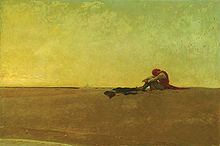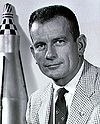- Marooned (film)
-
Marooned 
Directed by John Sturges Produced by M.J. Frankovich
Frank Capra Jr.Written by Martin Caidin
Mayo SimonStarring Gregory Peck
Richard Crenna
David Janssen
James Franciscus
Gene Hackman
Lee Grant
Mariette Hartley
Nancy KovackEditing by Walter Thompson Distributed by Columbia Pictures Release date(s) November 10, 1969 Running time 134 minutes Country United States Language English Budget $8,000,000 Marooned is a 1969 American film directed by John Sturges and starring Gregory Peck, Richard Crenna, David Janssen, James Franciscus, and Gene Hackman.
The film was released less than four months after the Apollo 11 moon landing and was tied to the public fascination with the event. It won an Academy Award for Visual Effects.
It was based on the 1964 novel of the same name by Martin Caidin; however, while the original novel was based on the single-pilot Mercury program, the film depicted an Apollo Command/Service Module with three astronauts and a space station resembling Skylab. Caidin acted as technical adviser and updated the novel, incorporating appropriate material from the original version.
Contents
Plot
Three American astronauts—commander Jim Pruett (Crenna), "Buzz" Lloyd (Hackman), and Clayton "Stoney" Stone (Franciscus)—are the first crew of an experimental space station. While returning to Earth, the main engine on the Apollo spacecraft Ironman One fails. Mission Control determines that Ironman does not have enough backup thruster capability to initiate atmospheric reentry, or to re-dock with the station and wait for rescue. The crew is marooned in orbit.
NASA debates whether a rescue flight can reach the crew before their oxygen runs out in approximately two days. There are no backup launch vehicles or rescue systems available at Kennedy Space Center and NASA director Charles Keith (Peck) opposes using an experimental Air Force X-RV lifting body that would be launched on a Titan IIIC booster; neither the spacecraft nor the booster is man-rated, and there is insufficient time to put a new manned NASA mission together. Even though a booster is already on the way to nearby Cape Canaveral Air Force Station for an already-scheduled Air Force launch, many hundreds of hours of preparation, assembly, and testing would be necessary.
Ted Dougherty (Janssen), the Chief Astronaut, opposes Keith and demands that something be done. The President agrees with Dougherty and tells Keith that failing to try a rescue mission will kill public support for the manned space program. The President tells Keith that money is no factor; "whatever you need, you've got it".
While the astronauts' wives (Lee Grant, Mariette Hartley, and Nancy Kovack) agonize over the fates of their husbands, all normal checklist procedures are bypassed to prepare the X-RV for launch. A hurricane headed for the launch area threatens to cancel the mission. However, the eye of the storm passes over the Cape at the last minute during a launch window, permitting a launch with Dougherty aboard.
 Pruett (Richard Crenna) subdues an unruly Lloyd (Gene Hackman) in Ironman One.
Pruett (Richard Crenna) subdues an unruly Lloyd (Gene Hackman) in Ironman One.
There is insufficient oxygen left for all three astronauts to survive until Dougherty arrives. There is possibly enough for two. Pruett and his crew then debate what to do. Stone tries to reason that they can somehow survive. Lloyd offers to leave since he is "using up most of the oxygen anyway", but Pruett overrides him. He orders everyone into their spacesuits then leaves the ship, ostensibly to attempt repairs. When Lloyd realizes what Pruett is really intending, he attempts to go after him. Before he can reach Pruett, the latter sacrifices himself by tearing open his space suit, and his body drifts away into space. With Pruett gone, Stone takes command.
A Soviet spacecraft suddenly appears and its cosmonaut tries to make contact. It can do nothing but deliver oxygen since the Soviet ship is too small to carry additional passengers. Stone and Lloyd, suffering oxygen deprivation, cannot understand the cosmonaut's gestures or obey Keith's orders.
Dougherty arrives and he and the cosmonaut transfer the two surviving and mentally dazed Ironman astronauts into the rescue ship. Both the Soviet ship and the X-RV return to Earth, and the final scene fades out with a view of the abandoned Ironman One adrift in orbit.
Technical aspects
One way that the filmmakers tried to enhance the realism of the film was through the use of such items as the actual Plantronics headsets worn by the actors in the spacecraft, as well as authentic replicas of actual facilities such as the Mission Operations Control Room (MOCR) at Johnson Space Center in Houston and the Air Force Launch Control Center (AFLCC) at Cape Canaveral AFS. While most films strive to avoid "incidental" sounds, the headsets picked up the actors' breathing and other sounds.
The names of the film astronauts (Jim, Buzz and Stoney) were chosen out of the blue, not to reflect on the real astronauts with those names.
Ted Dougherty closely resembled real-life Chief Astronaut "Deke" Slayton, both in character and physical appearance. While Slayton, one of the Mercury Seven, had been grounded due to suspected heart problems, the film put him into space as the pilot of the rescue ship. David Janssen, who was a pilot himself, was selected in part due to his resemblance to Slayton.[citation needed]
In 1975, Slayton was medically cleared, and made his only space flight on the Apollo-Soyuz Test Project, which may have been partially inspired by Marooned.[1][2] The agreement between the U.S. and U.S.S.R. to conduct the ASTP was signed in Moscow in April, 1971.
The MOCR and AFLCC sets were built by Philco-Ford Corporation, builders of the actual facilities. Many of the technical personnel seen in those sets were Philco-Ford technicians.
In his book Lost Moon, Apollo 13 commander Jim Lovell reported that he had taken his wife, Marilyn, to see Marooned.[citation needed] This added to her worries in the weeks leading up to the launch of the ill-fated mission. (The "nightmare" scene in the Ron Howard film Apollo 13 depicts this.)
The Apollo Command Module used in making the film was an actual "boilerplate" version of the "Block I" Apollo spacecraft (no Block I ever flew with a crew aboard). While the Block II series had a means of rapidly blowing the hatch open, the Block I did not, and the interior set was constructed using the boilerplate as a model. To blow the hatch in the movie, Buzz pulls on a handle attached to a hinge.
Several scenes show various people communicating directly with the astronauts in space. In actuality, only CAPCOM (an astronaut) and astronauts' wives would have been permitted to communicate with the spacecraft, all others in MOCR and AFLCC would only be able to communicate on the internal network or to their respective backroom teams.[citation needed]
While the Titan IIIC was described as the booster which would launch the X-RV rescue craft into orbit, the only available launch footage (other than well-known Mercury and Gemini missions) was of an Air Force Titan II. The aerodynamic shroud placed over the lifting-body was designed to resemble a similar shroud which protects Titan payloads.
Conspicuously absent from the film is any person resembling a Flight Director. In real life, "Flight" is in charge of a space mission during that director's shift. The filmmakers felt that adding a Flight Director would distract from the interpersonal dynamic between Keith and Dougherty.
The offscreen voice of the President closely resembles that of Robert F. Kennedy, who had been a candidate for that office at the time of production. Following his assassination in 1968, producers decided not to re-record the audio with a different accent.
While flying the Manned Maneuvering Unit, Lloyd's control inputs not only take place after the movements begin, but are also the opposite of what they should be, to match the preflight test shown a moment before.
The film's legacy
For the 1969 Academy Awards held in 1970, the presenter for the Best Visual Effects award was Raquel Welch. There were two nominees (Krakatoa: East of Java was the other). Before announcing the nominees, the buxom Welch said "I am here for visual effects and I have two of them."[3] The film was also nominated for Cinematography and Best Sound (Les Fresholtz, Arthur Piantadosi).[4]
During the preliminary discussions for the Apollo-Soyuz Test Project the film was discussed as a means of disarming Russian suspicion.[5]
The Skylab Rescue space vehicle was conceived by technicians at North American Rockwell after the film's release and the Apollo 13 disaster. A production Apollo Command Module was modified into this configuration. Equipment failure aboard Skylab 3 with the Apollo CSM thrusters almost led to Skylab Rescue's launch.
In the 1980s, Marooned was redistributed under the name Space Travelers by Film Ventures International, an ultra-low-budget production company that prepared quickie television and video releases of films that were in the public domain or could be purchased inexpensively. As Space Travelers, Marooned was mocked on a 1992 episode of Mystery Science Theater 3000, becoming the only Academy Award-winning film ever to receive the MST3K treatment.
The second launch sequence served as the speech base for the comm chatter in the Disney rollercoaster Space Mountain.
References
- ^ Shepard, Alan; Slayton, Deke; Barbree, Jay; Benedict Howard, MoonShot: The Inside Story of the Apollo Project
- ^ Philip Handler to Ezell, 9 Oct. 1974.
- ^ http://www.tv.com/raquel-welch/person/20028/trivia.html
- ^ "The 42nd Academy Awards (1970) Nominees and Winners". oscars.org. http://www.oscars.org/awards/academyawards/legacy/ceremony/42nd-winners.html. Retrieved 2011-08-26.
- ^ http://www.hq.nasa.gov/office/pao/History/SP-4209/toc.htm Edward Clinton Ezell & Linda Neuman Ezell The Partnership: A History of the Apollo-Soyuz Test Project
External links
- Marooned at the Internet Movie Database
- Marooned at AllRovi
- Marooned on Cloudster.com - Site with pictures of the models used in the film.
Films directed by John Sturges 1940s The Man Who Dared (1946) · Shadowed (1946) · Alias Mr. Twilight (1946) · For the Love of Rusty (1947) · Keeper of the Bees (1947) · The Sign of the Ram (1948) · Best Man Wins (1948) · The Walking Hills (1949)1950s The Capture (1950) · Mystery Street (1950) · Right Cross (1950) · The Magnificent Yankee (1950) · Kind Lady (1951) · The People Against O'Hara (1951) · It's a Big Country (1951) · The Girl in White (1952) · Jeopardy (1953) · Fast Company (1953) · Escape from Fort Bravo (1953) · Bad Day at Black Rock (1955) · Underwater! (1955) · The Scarlet Coat (1955) · Backlash (1956) · Gunfight at the O.K. Corral (1957) · The Law and Jake Wade (1958) · The Old Man and the Sea (1958) · Last Train from Gun Hill (1959) · Never So Few (1959)1960s The Magnificent Seven (1960) · By Love Possessed (1961) · Sergeants 3 (1962) · A Girl Named Tamiko (1962) · The Great Escape (1963) · The Satan Bug (1965) · The Hallelujah Trail (1965) · Hour of the Gun (1967) · Ice Station Zebra (1968) · Marooned (1969)1970s Categories:- American films
- English-language films
- 1969 films
- Films that won the Best Visual Effects Academy Award
- 1960s science fiction films
- Apollo program films
- Space adventure films
- Films based on science fiction novels
- Mystery Science Theater 3000 episodes
- Films directed by John Sturges
Wikimedia Foundation. 2010.

